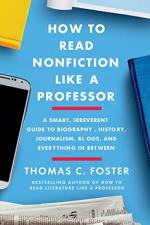
|
| Name: _________________________ | Period: ___________________ |
This quiz consists of 5 multiple choice and 5 short answer questions through Section 2: Chapter 5, "It May Just Be Me, But..." through Chapter 8, "Bringing the News".
Multiple Choice Questions
1. In Chapter 6, "Source Code," which is the only type of nonfiction that Foster says doesn't need "rock-solid" sources (69)?
(a) Philosophy.
(b) Reportage.
(c) Biography.
(d) Memoir.
2. In Chapter 5, "It May Just Be Me, But..." what does Foster say is true about quotes attributed to anonymous sources?
(a) There is never a good reason to use a quote from an anonymous source.
(b) These quotes are often made up.
(c) These quotes are often just the reporter's interpretation of a source's meaning.
(d) There are likely to be good reasons for the source to stay anonymous.
3. In Chapter 1, "The Structure of Nonfiction Information," what does Foster mean when he uses the word "dichotomy"?
(a) The study of social policy.
(b) Something relatively unknown.
(c) A narrative told in the order in which events really happened.
(d) A division between opposite things.
4. In Chapter 7, "All in How You Look at Things," Foster discusses Pollan's How to Change Your Mind as an example of what?
(a) Science writing that does not use chronological order.
(b) Why self-help books are better off using a chronological structure.
(c) Why self-help books can use many non-chronological structures.
(d) Science writing that begins in media res.
5. In Chapter 3, "The Power of the Prologue," why is "foreward" spelled with an "e" instead of as we usually see it, "forward"?
(a) Foster is using an unconventional spelling to draw attention to the idea "fore," which means "ahead."
(b) Without the "e," the word means a direction; with the "e," it means a piece of writing that comes ahead of another.
(c) This is a proofreading error in the text.
(d) The spelling "foreward" is a British spelling, like "flavour," and is therefore an accepted alternate spelling.
Short Answer Questions
1. In Chapter 5, "It May Just Be Me, But..." what does Foster say about disclaimers like "I don't dislike soccer" (52)?
2. In Chapter 3, "The Power of the Prologue," Foster mentions a "squib." What is a squib, in this context?
3. In Chapter 6, "Source Code," what does Foster say is an advantage of using data as evidence?
4. Which form discussed in Chapter 3, "The Power of the Prologue," is generally not written by the author of the main piece of writing?
5. In Chapter 7, "All in How You Look at Things," Foster tells us that changing the structure of a story changes its what?
|
This section contains 487 words (approx. 2 pages at 300 words per page) |

|




